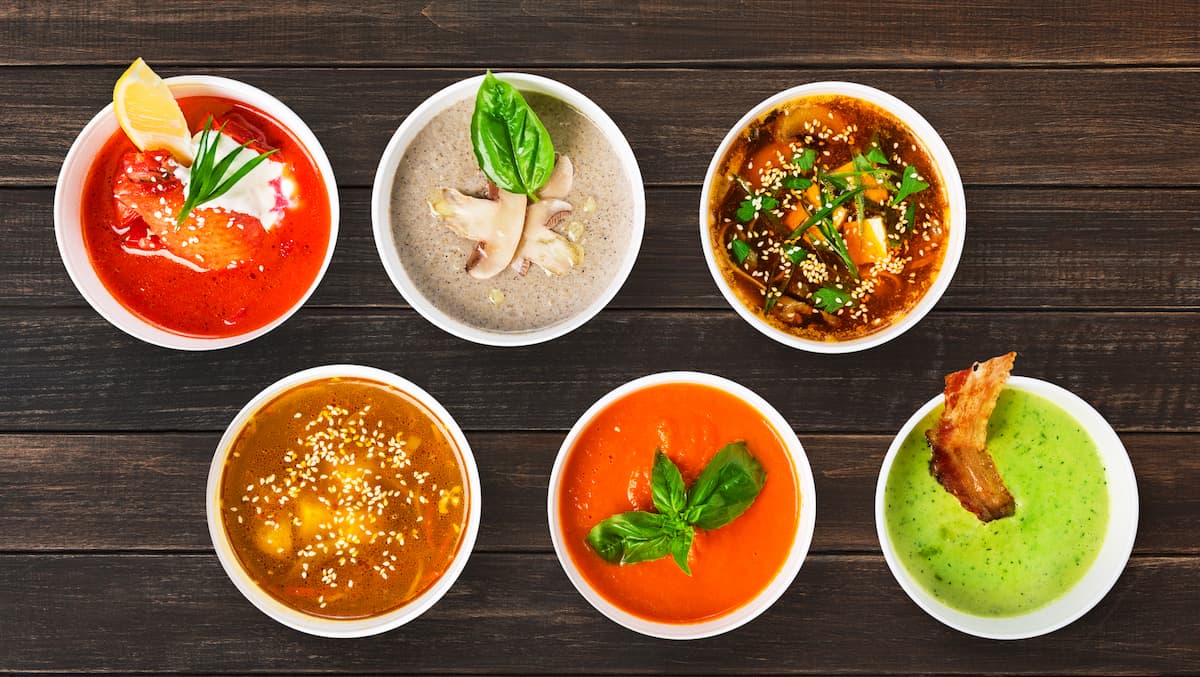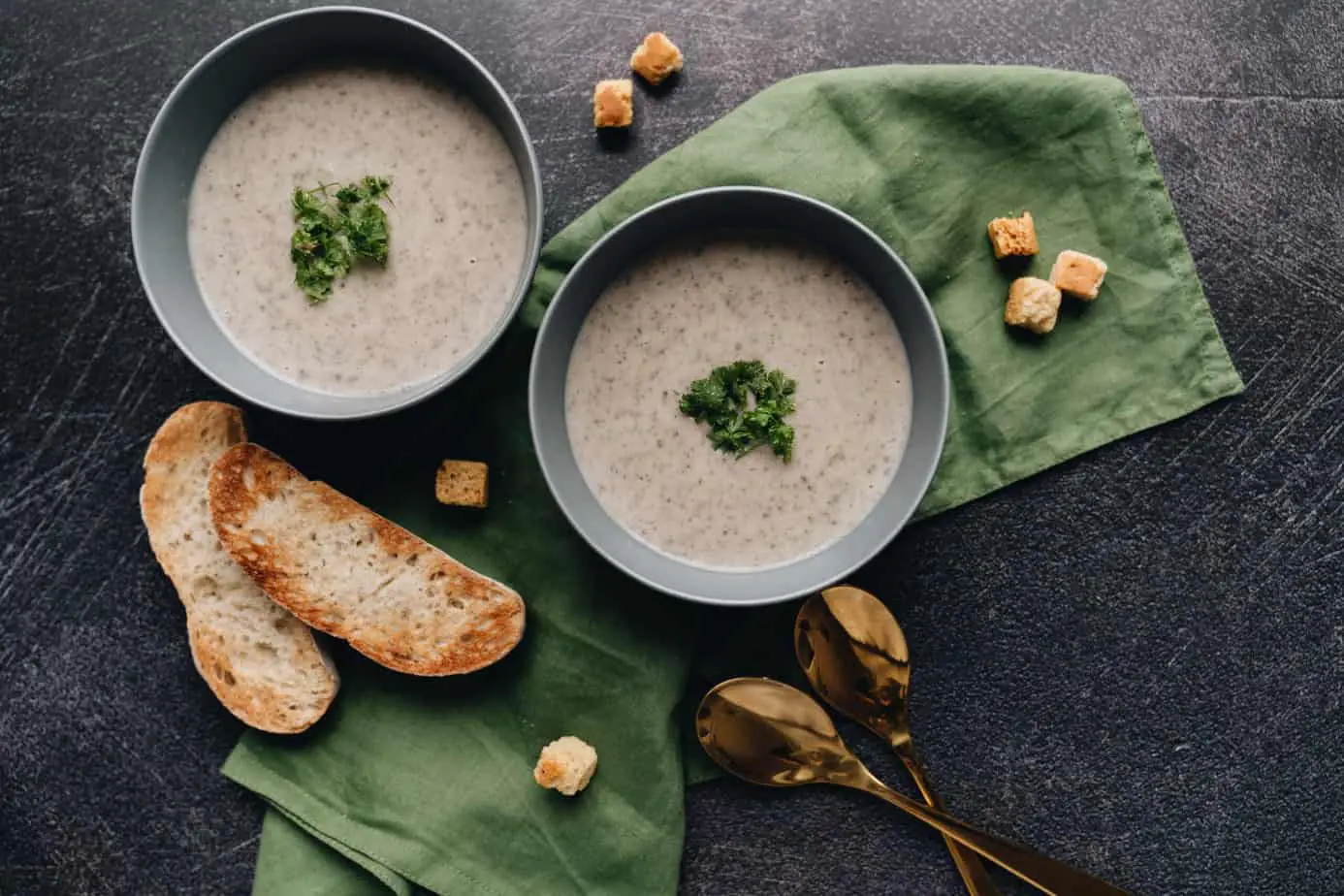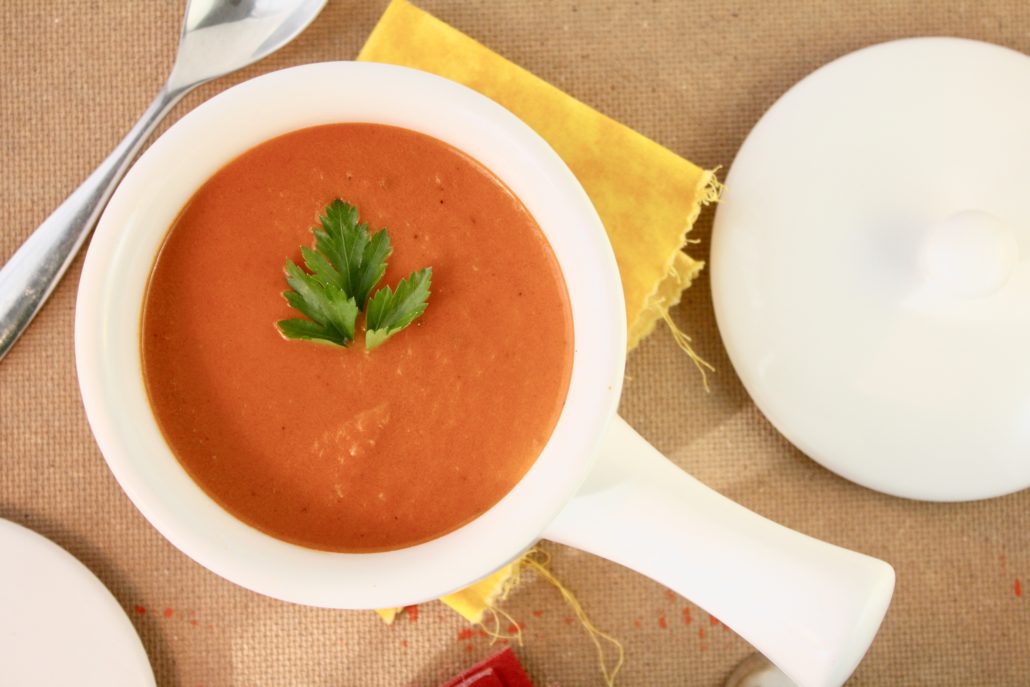Introduction

When it comes to comforting and delicious meals, soups are a universal favorite. Whether it’s a warm bowl of chowder, a hearty soup, or a velvety bisque, these varieties of soups offer different flavors and textures that can satisfy any palate. In this article, we will explore the differences between chowder, soup, and bisque – from their origins and ingredients to their distinct characteristics. Whether you’re a soup enthusiast or simply looking to expand your culinary knowledge, this exploration of soup varieties is sure to leave you feeling inspired to try new recipes and savor the diverse flavors of these soups.
Overview And History Of Soups
Soups have a rich history that dates back to primitive times. It is believed that the first soups were created by dropping hot rocks into liquids to heat them. Over the centuries, soups have evolved into various forms and flavors, becoming a staple in many cuisines around the world. They are loved for their versatility, comforting nature, and ability to showcase a wide range of ingredients. From hearty stews and creamy bisques to light broths and flavorful chowders, soups have a long-standing presence in culinary traditions worldwide.
Difference Between Chowder, Soup, And Bisque
Chowder, soup, and bisque are all types of soups, but they have distinct characteristics that set them apart.
- Chowder: Chowder is a thick and chunky soup that typically includes ingredients like potatoes, onions, and seafood or vegetables. It has a creamy and rich base, often thickened with flour or cream.
- Soup: Soup is a general term for a liquid dish made by simmering various ingredients, such as meats, vegetables, and grains, in a flavorful broth. It can be thin or thick, clear or creamy, depending on the recipe.
- Bisque: Bisque is a type of soup that is usually made with a pureed base, such as shellfish or vegetables. It is typically smooth and velvety in texture, with a rich and indulgent flavor.
While chowder has a thicker consistency and usually contains chunks of ingredients, soups can vary in texture and can be clear, broth-based, or cream-based. Bisque, on the other hand, is known for its smooth and pureed texture.
Chowder

Chowder is a type of soup that is known for its thick and chunky consistency. It originated in North America and has become a popular dish worldwide. Chowder is typically made with ingredients such as potatoes, onions, and seafood or vegetables, giving it a hearty and flavorful taste. The base of chowder is often creamy and rich, achieved by thickening it with flour or cream. Some popular varieties of chowder include New England-style with clams, Manhattan-style with tomatoes, and corn chowder. Chowder is a comforting and satisfying soup option that is perfect for colder weather or anytime you crave a hearty meal.
Chowder Definition And Origin
Chowder is a type of soup known for its thick and chunky texture. It originated in North America and has since become popular worldwide. The word “chowder” is believed to have derived from the French word “chaudière,” which means a cooking pot or cauldron. The early versions of chowder were made by European settlers in America, who combined local ingredients such as potatoes, onions, and seafood. Over time, chowder recipes evolved to include variations like New England-style with clams, Manhattan-style with tomatoes, and corn chowder.
Varieties Of Chowder: New England, Manhattan, And More
Chowder comes in various regional variations, each with its unique ingredients and flavors. The most well-known varieties include New England and Manhattan chowder. New England chowder is creamy and made with clams, potatoes, onions, and sometimes bacon. On the other hand, Manhattan chowder is tomato-based and features a mix of seafood, such as clams, shrimp, and fish. Other variations of chowder can include ingredients like corn, crab, or even vegetables for a vegetarian option. Each variety offers a distinct taste and is enjoyed by chowder enthusiasts around the world.
Soup

Soup is a versatile and widely beloved dish that has been enjoyed for centuries. It is typically made by combining various ingredients such as vegetables, meat, or seafood with a flavorful liquid, such as broth or stock. Soup has a long history and cultural significance in countries around the world, with each region putting their own unique twist on this comforting dish. There are various types of soup, including clear soups, broth-based soups, cream-based soups, and more. From chicken noodle soup to tomato bisque, soup offers a wide range of flavors and textures to suit different tastes and preferences.
Soup Explanation And Cultural Significance
Soup is a versatile dish that has been enjoyed for centuries, with each culture putting its own unique twist on this comforting meal. It is made by combining various ingredients such as vegetables, meat, or seafood with a flavorful liquid like broth or stock. Soup holds cultural significance as it often represents communal gatherings and comfort. It is a staple in many cuisines around the world, from hearty stews in Europe to spicy soups in Asia. Whether it’s a warm bowl of chicken noodle soup on a sick day or a spicy pho shared with friends, soup has a way of bringing people together and nourishing both the body and the soul.
Types Of Soup: Clear, Broth-based, Cream-based, And More
There are various types of soup, each with its own distinct characteristics and flavors. Clear soups are light and transparent, made by simmering ingredients in a clear broth or stock. Broth-based soups are similar to clear soups but may contain chunkier ingredients. Cream-based soups are rich and velvety, made by blending a main ingredient with milk or cream. Other types of soup include vegetable soups, bean soups, and noodle soups. These different varieties offer a wide range of options to suit different tastes and dietary preferences.
Bisque

Bisque is a type of soup that originated in France and is known for its smooth and velvety texture. Unlike traditional soups, bisque is typically made with shellfish as the main ingredient, such as lobster, crab, or shrimp. This rich and flavorful soup is created by combining the shellfish with a base of broth, cream, and aromatic ingredients like onions, garlic, and herbs. The result is a luxurious and indulgent soup that is often served as a starter or main course in fine dining establishments. Bisque is a favorite among seafood lovers seeking a taste of elegance.
Bisque Definition And French Influence
Bisque is a luxurious and smooth soup that originated in France and is renowned for its rich and velvety texture. Traditionally, bisque is made with shellfish, such as lobster, crab, or shrimp, which are simmered and then pureed to create a creamy base. The name “bisque” comes from the French phrase “bis cuites,” meaning “twice cooked,” as the shellfish is first cooked in its shell and then incorporated into the soup. The French influence is evident in the use of aromatic ingredients like onions, garlic, and herbs, which infuse the bisque with delightful flavors. This combination of techniques and ingredients gives bisque its distinctive taste and makes it a beloved classic in French cuisine.
Main Ingredients Of Bisque: Seafood, Vegetables, And More
Bisque is traditionally made with seafood as the main ingredient. Common choices include lobster, crab, or shrimp. These shellfish are cooked and then pureed to create the smooth and luxurious texture of the bisque. In addition to seafood, bisques often include a variety of vegetables such as onions, garlic, celery, and carrots. These vegetables add depth of flavor and enhance the overall taste of the bisque. Other ingredients may include herbs, spices, wine, and cream, which contribute to the rich and decadent nature of this classic French soup.
Characteristics And Differences

Chowder, soup, and bisque each have their own distinct characteristics and differences. Chowder is known for its thick and creamy texture, often made with potatoes and a variety of vegetables. Soup, on the other hand, can range from clear and broth-based to creamy and thick. Bisque, specifically seafood bisque, stands out for its smooth and luxurious consistency, derived from pureed shellfish. While chowder and soup encompass a wide variety of flavors and ingredients, bisque is primarily focused on seafood and vegetables. Overall, the main distinctions lie in texture, consistency, and ingredient profiles.
Texture, Consistency, And Ingredients Of Chowder, Soup, And Bisque
Chowder, soup, and bisque each have their own distinct characteristics when it comes to texture, consistency, and ingredients. Chowder is known for its thick and creamy texture, often achieved by adding potatoes and a variety of vegetables. Soup can vary in texture, ranging from clear and broth-based to creamy and thick, depending on the type of soup being made. Bisque, specifically seafood bisque, stands out for its smooth and luxurious consistency, derived from pureed shellfish. When it comes to ingredients, chowder and soup can encompass a wide variety of flavors and ingredients, while bisque is primarily focused on seafood and vegetables. So, whether you prefer a hearty and creamy texture or a lighter broth-based consistency, there is a soup variety to suit everyone’s taste.
Flavor Profiles And Regional Variations
The flavor profiles of chowder, soup, and bisque can vary significantly, influenced by the ingredients and regional variations. Chowders, such as New England clam chowder or corn chowder, have a rich and creamy base with a combination of vegetables, seafood, and sometimes bacon. Soups can range from light and refreshing with clear broths and delicate flavors to hearty and bold with ingredients like meat, vegetables, and spices. Bisques, usually made with shellfish, have a smooth and luxurious texture with a subtle sweetness. Regional variations add their own unique twists, incorporating local ingredients and culinary traditions.
Conclusion

In conclusion, exploring the world of chowder, soup, and bisque unveils a multitude of flavors and culinary traditions. While chowders offer a creamy and hearty experience, bisques delight with their smooth and luxurious textures. Soups, on the other hand, present a diverse range of options, from light and refreshing to robust and comforting. The choice between these varieties ultimately boils down to personal preference and the occasion. By understanding their characteristics and regional variations, one can embark on a flavorful journey filled with delicious soups for every palate.
Final Thoughts On Chowder, Soup, And Bisque
In conclusion, exploring the world of chowder, soup, and bisque unveils a multitude of flavors and culinary traditions. While chowders offer a creamy and hearty experience, bisques delight with their smooth and luxurious textures. Soups, on the other hand, present a diverse range of options, from light and refreshing to robust and comforting. The choice between these varieties ultimately boils down to personal preference and the occasion. By understanding their characteristics and regional variations, one can embark on a flavorful journey filled with delicious soups for every palate.
Choosing The Right Variety For Different Occasions
When it comes to choosing the right soup variety for different occasions, it’s important to consider the flavors, textures, and overall dining experience you want to create.
For casual gatherings or comforting meals, chowders make an excellent choice. Their hearty and creamy consistency is perfect for colder days or when you want something filling. New England chowder with its rich flavors is a classic option, while Manhattan chowder offers a lighter and tangier alternative.
For more elegant and refined occasions, bisques are a great choice. Their smooth texture and luxurious flavors, often derived from seafood, elevate the dining experience. Serve a lobster bisque or a creamy shrimp bisque to impress your guests.
When seeking versatility and lighter options, soups come to the rescue. Clear broths or vegetable-based soups are refreshing and ideal for a light meal or as a starter. Cream-based soups offer a comforting and velvety option, perfect for a cozy evening or when you want to indulge in a bowl of goodness.
It’s important to consider the preferences of your guests, dietary restrictions, and the overall theme of the meal when deciding on the soup variety. Ultimately, choosing the right soup can enhance any occasion and make it a memorable culinary experience.
Popular Recipes And Recommendations

Popular recipes and recommendations for chowder, soup, and bisque can vary depending on personal preferences and regional influences. However, some popular choices include New England clam chowder, chicken noodle soup, and lobster bisque. These recipes often feature fresh ingredients and a combination of flavors that create a delicious and comforting dining experience. For those looking for vegetarian options, a classic vegetable soup or a creamy potato and leek soup can be just as satisfying. Experimenting with different recipes and adding your own twist can also result in unique and flavorful soups.
Frequently Asked Questions About Chowder, Soup, and Bisque
Q: What is the difference between chowder, soup, and bisque?
A: While all three are delicious dishes, there are some key differences between chowder, soup, and bisque. Chowder is a hearty, thick soup typically made with seafood or vegetables, often containing chunky ingredients. Soup, on the other hand, is a more general term that refers to a liquid-based dish made with various ingredients like vegetables, meat, or legumes, and can be either clear or thick. Bisque is a type of soup, usually made with shellfish, that is known for its creamy and smooth texture.
Q: Are chowder, soup, and bisque only made with seafood?
A: No, not necessarily. While chowder and bisque often include seafood as the main ingredient, they can also be made with vegetables or other meats like chicken or bacon. Soups, being more versatile, can be made with a wide range of ingredients, such as vegetables, meat, legumes, grains, and even fruits.
Q: What are some popular types of chowder?
A: The most famous and well-loved variety of chowder is New England clam chowder, made with clams, potatoes, onions, cream, and sometimes bacon. Manhattan clam chowder and Rhode Island clam chowder are other variations of chowder that have different bases (tomato or clear broth). Additionally, corn chowder and seafood chowder are also popular choices.
Q: What are some popular types of soup?
A: There are countless types of soups enjoyed worldwide. Some popular examples include chicken noodle soup, tomato soup, minestrone, French onion soup, vegetable soup, lentil soup, and mushroom soup. Each culture has its own signature soups, making it a versatile and diverse dish.
Q: Is bisque always made with seafood?
A: Traditionally, bisque is made with shellfish, such as lobster, crab, or shrimp. However, in modern cuisine, the term “bisque” is sometimes used to describe any creamy and smooth soup, even if it doesn’t contain shellfish. Vegetable bisques made with ingredients like butternut squash or mushrooms have become quite popular.
Q: Are chowder, soup, and bisque healthy to eat?
A: The health benefits of these dishes can vary based on their ingredients and the way they are prepared. Chowders and bisques can be rich in calories and fat due to the addition of cream or butter, but they can still provide essential nutrients when made with healthier alternatives. Soups, especially those with a vegetable or legume base, are often seen as a healthier choice. Using lean proteins, whole grains, and plenty of vegetables can make these dishes nutritious and balanced.
Q: Can chowder, soup, and bisque be reheated?
A: Yes, these dishes can be reheated, but it’s important to do so properly. Make sure to heat them thoroughly to at least 165°F (74°C) to kill any potential bacteria. It’s best to reheat them gently over low to medium heat to avoid scorching or changing the texture. Some chowders and bisques may thicken when refrigerated, so you might need to add a bit of liquid (like broth or milk) when reheating to achieve the desired consistency.
Q: Are chowder, soup, and bisque best enjoyed fresh or can they be frozen?
A: Chowder, soup, and bisque can all be frozen, but it’s important to consider the ingredients. Cream-based chowders and bisques may separate or change in texture when frozen and thawed. However, vegetable-based soups and clear broth-based soups freeze quite well. To maintain the best flavor and texture, it’s recommended to consume them within 2-3 months after freezing.

From At-Home Dinner Parties to Family Reunions to Office Parties, we can cater your next Event!